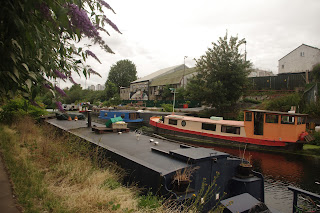I stood at this spot on January 30th. 2020, the mouth of the River Lea where it meets the Thames. I set myself the goal of walking back to the source in several stages. The Lea (or Lee) rises in the Chiltern Hills, a route of about 42 miles. That seemed like a nice little project for the year ahead; like everyone else on the planet 2020 didn't go according to plan. Anyway, I've decided to reactivate the idea starting today.
Towards Docklands are the remnants of a post-industrial landscape replaced for the most part by a whole new city of apartment blocks. There must be hundreds of thousands of people living on this side of town who weren't here ten or twenty years ago. And still more blocks are under construction.
From Hertford to Bow the Lea was split into a number of man-made channels for transport and industry. A working river even in Mediaeval times and the early days of the Industrial Revolution.
As the factories and warehouses closed in the 70s they were occupied by artists and bohemians who made use of the cheap and plentiful space for various creative endeavours. Only a few pockets of that way of life remain. The development of Docklands in the 80s and 90s and the "regeneration" triggered by the 2012 Olympics has erased that landscape. Money talks.
On today's leg I walked as far as the Carpenter's Road bridge. I had a studio further down the road in the mid-90s after leaving art school. It was in an enormous old building that housed hundreds of studios next to a vast scrapyard. The only amenity between here and Stratford was a stall that sold fried egg sandwiches and cups of tea. Now the vista from the bridge looks towards the Olympic stadium and Stratford's giant shopping mall.







